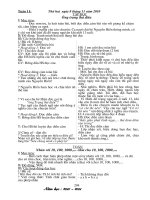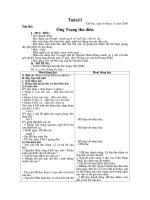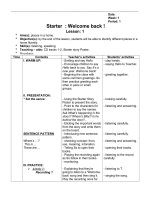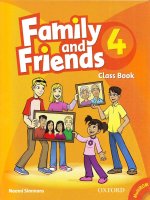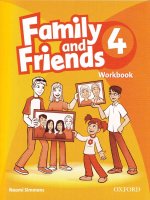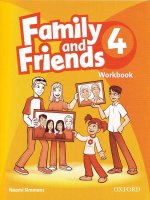- Trang chủ >>
- Đề thi >>
- Đề thi lớp 5
family and friends 4 tuan 11 15
Bạn đang xem bản rút gọn của tài liệu. Xem và tải ngay bản đầy đủ của tài liệu tại đây (168.54 KB, 26 trang )
Week 11
Monday, November 6 th , 2017
Lesson Four – Period 41
I/ Aims:
- Phonics - CVC words /e/, Speaking and writing skills.
II/ Language contents:
1.Structure:
2.Vocabulary: Foods and drinks: milk, juice, water
III/ Teaching Aids: CD tracks 28- 29, Phonic cards 7 -9.
IV/ Steps of teaching:
1.Warm up and reviews:
- Ask children if they can remember the words from the lesson that contained the
sound (cat, man, and fan). Play the CD and say the chant from page 17 to revise
the sound /æ/.
2. Presentation:
Listen, point and repeat
-Hold up the bed, pen, and red phonics cards, one at a time, saying the words for
the class to repeat. Ask children what they think today's letter is (e) and what sound
it makes (/e/). Ask children What's the vowel? to elicit e.
- Play the first part of the recording for children to listen and point to the pictures.
Play the second part of the recording for children to repeat the sounds and words in
chorus. Play the recording all the way through for children to point to the words
and then repeat them.
3. Practice:
Listen and chant
- Children join in with the chant. Put the three cards around the room and children
point as they say the chant.
----------------------------------------------------------------------------------------------------
Lesson Four – Period 42
I/ Aims:
- Phonics - CVC words /e/, Speaking and writing skills.
II/ Language contents:
1.Structure:
2.Vocabulary: Foods and drinks: milk, juice, water
III/ Teaching Aids: CD tracks 28-29, Phonic cards 7 -9.
IV/ Steps of teaching:
1.Warm up and reviews:
- Read out these sentences in turn: This is my pen. The apple is red. It's my pen. Is
Ken in bed? You've got ten pens. Ask children to tap the table when they hear a
word with the /e/ sound. They then say the sound and repeat the word.
2. Presentation:
Read the chant again.Circle the a in the middle of the words.
-Children look at the pictures. Point to each one for children to say the word. Pay
attention to the e and the /e/ sounds. Model a pair of rhyming words Ken and pen
to show how they rhyme. Ask children to draw lines to match the other rhyming
words. Go through the answers with the class.
3. Practice:
Match the words that rhyme:
- Children say and write the words. Put children in pairs. Ask them to point and
say the words.
1. Bed, red. 2. Pen, Ken
- Children do the exercise and write in the missing words to complete the chant.
Children can compare their work in pairs and join in the chant with the class as a
whole.
1. red. 2. Ken 3. bed
- Remind children of the letter a and /æ/ from unit 2. Contradict them with the
letter e and /e/. Ask children to do exercise 3. Children look at the pictures and
write the word that rhymes.
4. Production:
Phonics game: Ask children to work in groups of 4- 6. Ask each group to find
more rhymed words (a and /æ/ or e and /e/). Ask one group to say the words for
the class to tap the table when they hear e and /e/ and clap their hands when they
hear a and /æ.
V/ Extension: ........................................................................................................
--------------------------------------------------------------------------------------------------
Thursday, November 9 th , 2017
Lesson Five – Period 43
I/ Aims:
- Identifying foods and talking about likes and dislikes, Reading skills
II/ Language contents:
1.Structure:
2.Vocabulary: Menu, hungry, dessert, cafe
III/ Teaching Aids: CD tracks 30.
IV/ Steps of teaching:
1.Warm up and reviews:
-Play A long sentence (see page 21) with food and drinks words to energize the
class and revise vocabulary from the unit. E.g. (Teacher) In my lunch box I've got a
sandwich. (A child continues), In my lunch box I've got a sandwich and a banana.
Continue until children can't think of any more words.
2. Presentation:
What food do you like? Point and say.
- Ask Do you go to cafes? What kind of food can you eat in a café? Tell children to
imagine they are in a café. What kind of food would they order? Ask them to look
at the text on the black background and teach the word menu.
Listen and read
- Ask children to look at the menu. Check understanding of the different
categories: food, desserts, and drinks. Ask children to work in pairs. They take
turns to point to the types of food they like on the menu and say the words. Ask
some of the children to tell the class which food they like.
3. Practice:
- Ask children to look at the photos of Sally and Emma. Ask what they are looking
at (menus). Elicit that they are talking about the food they like on the menu. Play
the recording for children to listen and follow the text in their books. Play the
recording a second time, then check comprehension, e.g. Does Emma like ice
cream I fish? Does Sally like apple juice? Who likes bananas - Emma or Sally?
- Ask children to look at the different types of food in the table. Ask children to
read the text and tick () the food that the children like and cross () the food they
don't like. Go through the answers with the class.
-------------------------------------------------------------------------------------------------Lesson Five – Period 44
I/ Aims:
- Identifying foods and talking about likes and dislikes, Reading skills
II/ Language contents:
1.Structure:
2.Vocabulary: Menu, hungry, dessert, cafe
III/ Teaching Aids: CD tracks 30.
IV/ Steps of teaching:
1.Warm up and reviews:
- Tell children to close their books. Tell them that you are going to play the
recording 30 again. Ask them to say the words Yum! and Yuck! to show that they
like or don't like foods. Play the recording again; they say Yum! or Yuck! when
they hear the foods Emma and Sally like or don't like.
2. Presentation:
- Children read the poem and pick up the food and drinks words in the poem. They
then work in pairs and compare the answers.
Eggs, bread, tomatoes, grapes, ice cream, orange juice, fish, rice, carrots,
yogurt, apple, water.
Ask children to put the words into different categories: food, drinks, desserts…
3. Practice:
- Children read the poem again and say what Steve or Alice has got. They then
write the names under each kind of food or drinks and match.
They then work in pairs and compare the answers.
-Talking about likes and dislikes: Give students the PMB activity 2 worksheet (p.
13). Children draw a smiley (for the food and drinks they like) or a sad face (for
the food and drinks they dislike). Children then work in pairs, ask and answer
about likes or dislikes.
4. Production:
Game: Children sit in groups of 4-6. Give a blank piece of paper to each child and
ask them to draw a table similar to the one in their Class Books, write the names of
their friends. Children take turns to ask their friends which foods they like / don't
like. The others should listen. Everyone completes the information in their charts.
Children continue until all the members of the group have described the foods they
like and don't like, and the table is complete.
V/ Extension: ......................................................................................................
----------------------------------------------------------------------------------------------------
Week 12
Monday, November 13 th , 2017
Lesson Six – Period 45
I/ Aims:
- Identifying food, talking about likes and dislikes, Listening and speaking skills
II/ Language contents:
1.Structure:
2.Vocabulary:
III/ Teaching Aids: CD tracks 31.
IV/ Steps of teaching:
1.Warm up and reviews:
- Ask children to name as many types of food from the menu in the last lesson as
they can. Put the relevant flashcards on the board. Use the words on the board to
play Order the letters (see page 20)
2. Presentation:
Listen and draw or
- Ask children to look at the photograph of the father and daughter in Exercise 1.
Ask children what they think they are doing (they are looking at a menu)
- Tell children that the girl is going to tell her dad what food she likes and doesn't
like and children must listen and draw a smiley if the girl likes the food and a sad
face if she doesn't. Play the recording for children to point to the foods, then pause
after the first item to show the example answer. Play the recording again for
children to complete their answers. Give feedback.
1. 2. 3. 4. 5. 6.
3 .Practice:
- Model the dialogue. Ask a pair of children to read the dialogue. Children work in
pairs, take turns to ask and answer the question What do you like? using the food
and drinks on the menu. Encourage children to say which kinds of food they don't
like as well. Ask some pairs to talk before the class.
----------------------------------------------------------------------------------------------------
Lesson Six – Period 46
I/ Aims:
- Identifying food, talking about likes and dislikes, Listening and speaking skills
II/ Language contents:
1.Structure:
2.Vocabulary:
III/ Teaching Aids: CD tracks 31.
IV/ Steps of teaching:
1.Warm up and reviews:
- Ask children to work in groups of 4- 6. Tell them that they are going to make
menus for their own cafe. Give each child a piece of plain paper and each group a
set of coloured pencils. Children think of a name for their cafe and write it at the
top of their menus. Children write their menus and illustrate them. Collect the
menus and display them on the wall.
2. Presentation:
- Elicit to show three of the contractions are short for (not). Children circle n’t and
match the sentences with contractions to the ones with full forms. Allow time for
children to finish the exercise. Check together. Ask What letter is missing? (o) to
focus on the contraction n’t.
3. Practice:
- Remind children of the contraction n’t. Ask them to read the sentences and circle
the contraction n’t. Check the answers with a partner.
- Children now read the sentences, rewrite them in short form with the contraction
n’t. Check the answers with a partner.
- Ask children to draw the smiley or sad face next to the food they like or dislike.
Children work in pairs, ask and answer the questions What do you like? What
don’t you like? To talk about the food they like or dislike.
- Ask children to draw the food and drinks they like or dislike. They then write
about themselves, using I like…. I don’t like…
4. Production:
Likes or dislikes: Ask children to work in groups of 4 -6, take turns to ask and
answer about the food and drinks they like or dislike. Children take notes of their
friends’ likes or dislikes. They then report before the class.
V/ Extension: ........................................................................................................
-------------------------------------------------------------------------------------------------
Thursday, November 16 th , 2017
Review 1
Period 47-48
I/ Aims:
- Review the knowledge in Units 1, 2, 3.
II/ Language contents:
1.Structure: He’s/She’s got short hair.
He/She hasn’t got long hair.
I like monkeys.
I don’t like tigers because they’re big.
Do you like carrots ? Yes, I do.
No, I don’t.
6. What do you like ? - I like yogurt.
2.Vocabulary: Descriptive adjectives: long, short, blond, brown, curly, straight,
big, little, tall.
- Shapes of the things: square, circle, triangle, rectangle.
- Animals: elephant, giraffe, monkey, tiger, snake, parrot.
- Body parts: face, nose, ears, arms, legs, eyes, hands, fingers.
- Food and drink: rice, meat, carrots, yogurt, fish, bread, milk, juice, water.
III/ Teaching Aids: teacher’s book, sts’ books
IV/ Steps of teaching:
1.Warm up and reviews:
- Singing the song “It’s square!”
-Guess “What animals has teacher got ?”
2. Presentation:
Circle the odd one out. Write
1.
2.
3.
4.
5.
triangle
giraffe
milk
snake
hair
circle
rectangle
water
yogurt
meat
Write: It’s got / It’s hasn’t got
1. It’s got / It’s hasn’t got
rice
square
lion
tiger
juice
parrot
monkey
elephant
eyes
ears
2. It’s got / It’s hasn’t got
3. It’s hasn’t got / It’s got
4. It’s hasn’t got / It’s got
Look at the pictures. Read and circle.
1. Like – like – don’t like
2. don’t like- like - like
Look at the pictures and write.
a
e
man
red
cat
pen
fan
bed
3. Practice:
Write and letters.
1. Ben
2. Daniel
5. Sophie
6. Emily
Listen and write the names.
1.
2.
3.
4.
5.
6.
Daniel
Emily
Ben
Grace
Alfie
Sophie and Ben
Listen and write.
1.
2.
3.
4.
There is 1 carrot.
There are 6 triangles.
There are 8 tomatoes.
There are 2 circles.
3. Grace
4. Alfie
5. There are 3 ice creams.
6. There are 4 squares.
4. Production:
Listening:
1.
2.
3.
4.
5.
How old is Jade?
8
What is Jack’s friend called? Danny
How many parrot has the zoo got?
3
What’s the tiger’s name? Khan
How old is it? 10
V/ Extension: ........................................................................................................
-------------------------------------------------------------------------------------------------
Week 13
Monday, November 20 th , 2017
Unit 4: Tidy up !
Lesson One – Period 49
I/ Aims:
- Identifying things in a bedroom
II/ Language contents:
1.Structure:
2.Vocabulary: My bedroom: rug, bed, cupboard, shelf, pillow, blanket
III/ Teaching Aids: My bedroom flashcards 29-34; Story Poster 4; CD tracks 3638; PMB p. 16_ Extra Activity 1 Worksheet
IV/ Steps of teaching:
1.Warm up and reviews:
- Sing Come into my house from page 56 to warm the class up and revise houses
vocabulary. Tell children that today's story is about keeping your bedroom tidy.
Talk about bedrooms with children. Ask What's in your bedroom? Is it tidy or
messy?
2. Presentation:
- Use flashcards 29-34 to elicit the vocabulary for this lesson. Hold them up one at
a time and ask What's this? Model any words children don't know. Hold the
flashcards up in a different order and repeat.
3. Practice:
Listen , point and repeat.
- Ask children to look at the pictures of the different bedroom objects. Play the first
part of the recording for children to listen and point to the appropriate picture. Play
the second part of the recording for children to repeat. Play the recording all the
way through again for children to listen and point and then repeat the words in
chorus.
Listen and chant.
- Play the recording for children to listen to the chant. They can clap the rhythm as
they listen. Play the chant a second time for children to say the words. This time
they can point to the correct flashcard as they hear the word. Repeat (more than
once if necessary).
----------------------------------------------------------------------------------------------------
Lesson One – Period 50
I/ Aims:
- Identifying things in a bedroom
II/ Language contents:
1.Structure:
2.Vocabulary: My bedroom: rug, bed, cupboard, shelf, pillow, blanket
III/ Teaching Aids: My bedroom flashcards 29-34; Story Poster 4; CD tracks 3638; PMB p. 16_ Extra Activity 1 Worksheet
IV/ Steps of teaching:
1.Warm up and reviews:
- Ask children to say the chant again to review my bedroom words.
2. Presentation:
Listen and read
- Use Story poster 4 to present the story. Ask Where are Rosy and Grandma?
Where’s Billy? What rooms can you see? Encourage predictions from different
members of the class. Ask children to look at the poster while you play the
recording for them to listen. Point to each speech bubble in turn as you hear the
text. Ask comprehension questions, e.g. Is Rosy’s room tidy? What does Rosy do?
Is the flat tidy? Why is the kitchen messy?
3. Practice:
-Ask children to work in pair the dialogue.
- Ask children to look at the pictures carefully, read and draw things (pillow,
blanket, book, pen, T-shirt, teddy) in the bedroom. Children then work in pairs to
compare their works.
4. Production:
My bedroom: Draw a large rectangle on the board. Tell the class that it is a
bedroom. Invite individual children to come to the front of the class and draw the
different things in the rectangle, e.g. Max, please draw a cupboard. Rebecca,
please draw a bed. Continue until the bedroom is complete.
V/ Extension: ........................................................................................................
Thursday, November 23 th , 2017
Lesson Two – Period 51
I/ Aims:
- Identifying things in a bedroom.
II/ Language contents:
1.Structure: There’s …, There are…
2.Vocabulary: : My bedroom: rug, bed, cupboard, shelf, pillow, blanket
III/ Teaching Aids: My bedroom flashcards 29-34; Story Poster 4; CD tracks 3638;
IV/ Steps of teaching:
1.Warm up and reviews:
- Play a game of Snap! (see page 19) using flashcards 29- 34 to energize the class
and revise the vocabulary from the previous lesson.
2. Presentation:
Listen to the story again and repeat.Act
- Point to Story poster 4 and ask children what happened in the story. Cover the
poster and ask children which bedroom objects appeared in the story.
- Ask children to turn to the story on page 30 of their Class Books. Play the
recording, pausing for children to repeat. Divide the class into groups of three to
play the parts of Rosy, Grandma, and Billy. Children practise acting out the story
in groups, then before the class.
Look and say
- Use different flashcards to elicit the pattern There's and There are. Say different
sentences using plural and singular objects, e.g. There's a book on the desk. There
are some pens on the book. Pay attention to the contraction: There’s = There is
3. Practice:
- Ask children to work in pairs. They turn back to the story on page 30 of their
Class Books. Children take turns to tell each other about the things they can see,
e.g. There's a shelf. There are six books.
----------------------------------------------------------------------------------------------------
Lesson Two – Period 52
I/ Aims:
- Identifying things in a bedroom.
II/ Language contents:
1.Structure: There’s …, There are…
2.Vocabulary: : My bedroom: rug, bed, cupboard, shelf, pillow, blanket
III/ Teaching Aids: My bedroom flashcards 29-34; Story Poster 4; CD tracks 3638;
IV/ Steps of teaching:
1.Warm up and reviews:
- Remind children of the pattern There’s (There is) or There are
2. Presentation:
Write:
- Write three or four gapped sentences on the board using bedroom objects, e.g.
_____a cupboard. _____ two pillows. _____a bed. _____two rugs. Point to each
sentence in turn and ask There's or There are? Complete the sentences on the
board and say them with the class. Ask children to do Exercise 3 individually. Go
through the answers with the class.
3. Practice:
Look at the picture again.Point, ask and answer.
- Ask children to sit in pairs, look at the pictures from Ex 3. They then practice
asking and answering. E.g. How many blankets? There’s one blanket. Ask some
pairs to speak before the class.
4. Production:
Game: Our bedroom: Ask children to work in groups of 4 – 6. Give each group a
blank sheet of paper. Ask one child to draw a large rectangle on the sheet. Tell the
group that it is a bedroom. Invite individual group member to identify different
things in the rectangle, e.g. (Mary), There is a cupboard. (David), There is a bed.
Continue until the bedroom is complete. Encourage children to state the position of
each item.
Ask one child from each group to come before the class and talk about their
bedroom.
V/ Extension: ........................................................................................................
------------------------------------------------------------------------------------------------
Week 14
Monday, November 27 th , 2017
Lesson Three – Period 53
I/ Aims:
- Using numbers 11 - 20
II/ Language contents:
1.Structure:
2.Vocabulary: Numbers 1 – 20
III/ Teaching Aids: Number flashcards 35- 44, CD tracks 39- 40
IV/ Steps of teaching:
1.Warm up and reviews:
- Revise numbers 1- 10. Ask ten children to come to the front of the class. Give
each one a number flashcard and ask them to arrange themselves so they are
standing in the correct order from one to ten. Chorus the numbers with the class.
2. Presentation:
- Use flashcards 35- 44 to introduce the numbers 11- 20. Hold up the cards one at
a time and model the words for children to repeat. Ask ten different children to
come to the front of the class. As before, give each one a flashcard and ask them to
stand in the correct order. Say the numbers with the class.
3. Practice:
Listen, point and repeat.
- Ask children to look at the numbers in their Class Books. Play the first part of
the recording for children to point to the words. Play the second part of the
recording for children to repeat the words. Play the recording all the way through
again for children to listen and point and then repeat.
---------------------------------------------------------------------------------------------------Lesson Three – Period 54
I/ Aims:
- Using numbers 11 - 20
II/ Language contents:
1.Structure:
2.Vocabulary: Numbers 1 – 20
III/ Teaching Aids: Number flashcards 35- 44, CD tracks 39- 40
IV/ Steps of teaching:
1.Warm up and reviews:
- Play Forwards and backwards (see page 21) if the class feel confident using
numbers one to ten.
- Use flashcards 35- 44 to review numbers 11- 20. Hold up the cards one at a time
and model the words for children to repeat. Ask ten different children to come to
the front of the class. As before, give each one a flashcard and ask them to stand in
the correct order. Say the numbers with the class.
2. Presentation:
Listen and sing.
- Use the song worksheet (without opening the Class Book) where children listen
and fill in the correct words. After that ask children to sing along with the CD and
then sing together without the CD audio.
3. Practice:
Sing and do.
- Ask children to look at the pictures and decide together on what the actions
should be (see suggestions below). Practise the actions with the class. Play the
recording for children to listen and do their actions.
4. Production:
Count and sing: Count around the class. Start the game yourself. Say one and then
point to the child nearest you to say two. The child nearest him / her says three, and
so on. Continue to count around to twenty and then continue with one again till the
last child of the class. Play the recording 40. Ask children to listen to the song and
jump up in the air if they hear their number.
V/ Extension: ........................................................................................................
Thursday, November 30 th , 2017
Lesson Four – Period 55
I/ Aims:
- Phonics - CVC words /i/, Speaking and writing skills
II/ Language contents:
1.Structure:
2.Vocabulary: CD Tracks 41- 43, Phonics cards 10- 12
III/ Teaching Aids:
IV/ Steps of teaching:
1.Warm up and reviews:
- Review the vowel and sound in the previous lesson (e) and /e/. Play the CD and
say the chant from page 23 to energize the class and revise the sound /e/.
2. Presentation:
Listen, point and repeat
- Hold up the bin, fig, and tin phonics cards, one at a time, saying the words for the
class to repeat. Ask children what they think today's letter is (i) and what sound it
makes. Ask children What's the vowel? to elicit /i/.
- Play the first part of the recording for children to listen and point to the pictures.
Play the second part of the recording for children to repeat the sounds and words in
the chorus. Play the recording all the way through for children to point to the
words and then repeat them.
3. Practice:
Listen and chant
- Children join in with the chant. Put the three cards around the room and children
point as they say the chant.
----------------------------------------------------------------------------------------------------
Lesson Four – Period 56
I/ Aims:
- Phonics - CVC words /i/, Speaking and writing skills
II/ Language contents:
1.Structure:
2.Vocabulary: CD Tracks 41- 43, Phonics cards 10- 12
III/ Teaching Aids:
IV/ Steps of teaching:
1.Warm up and reviews:
- Read out the chant A big, big fig. In a big, big tin .Eat the big fig. Put the tin in
the bin .Ask children to tap the table when they hear a word with the /i/ sound.
They then say the sound and repeat the word.
2. Presentation:
Read the chant again.Circle the a in the middle of the words.
- Ask children to look at the chant again. Focus attention on the circled i in the
middle of big. Ask children to find and circle other examples of a in the middle of
words. Go through the exercise with the class.
3. Practice:
Listen to the sound and join the letters.
- Children look at the pictures. Play the recording for children to listen and link the
letters to find out what is in the bin. Play the recording again for children to check
their answers. Ask What is in the bin? (the tin) Then elicit the sounds children

